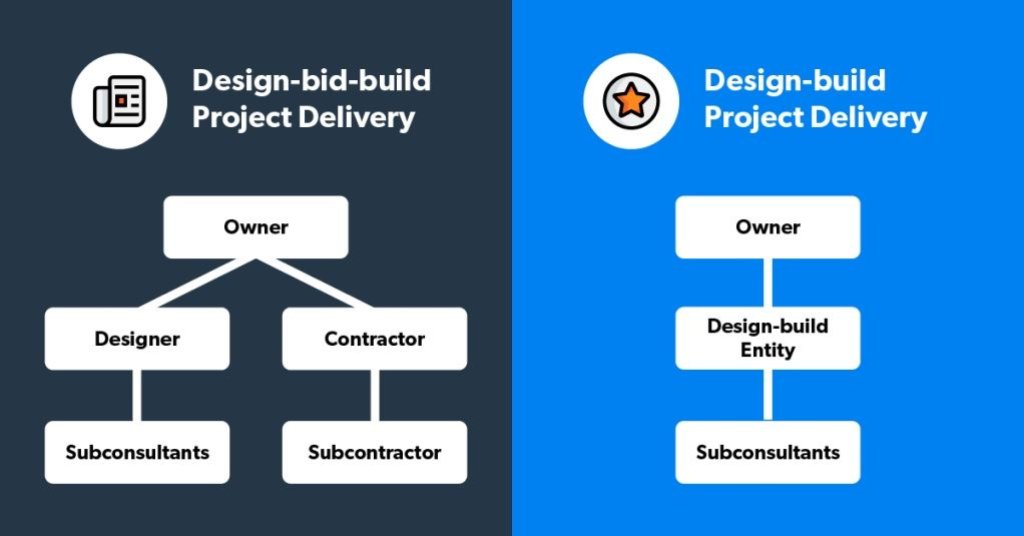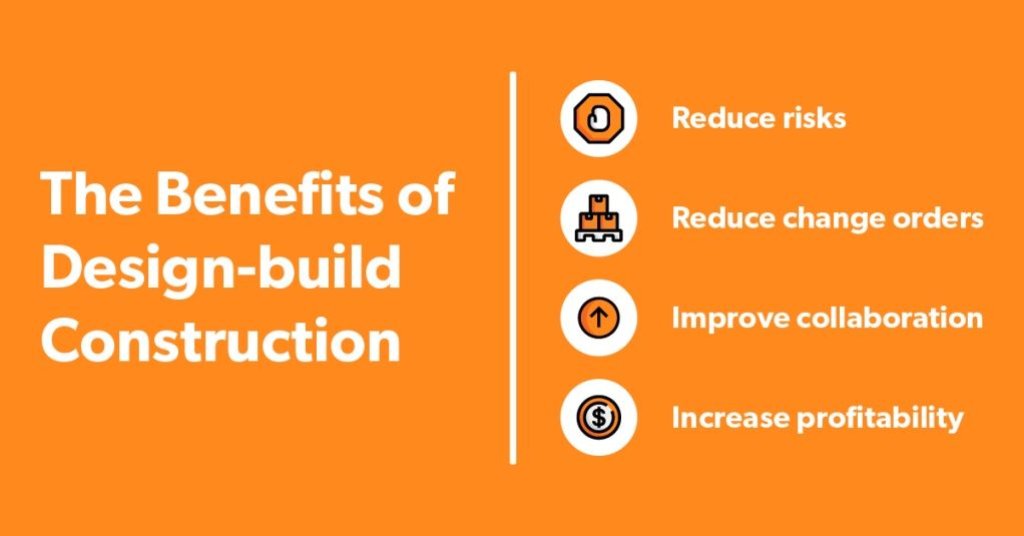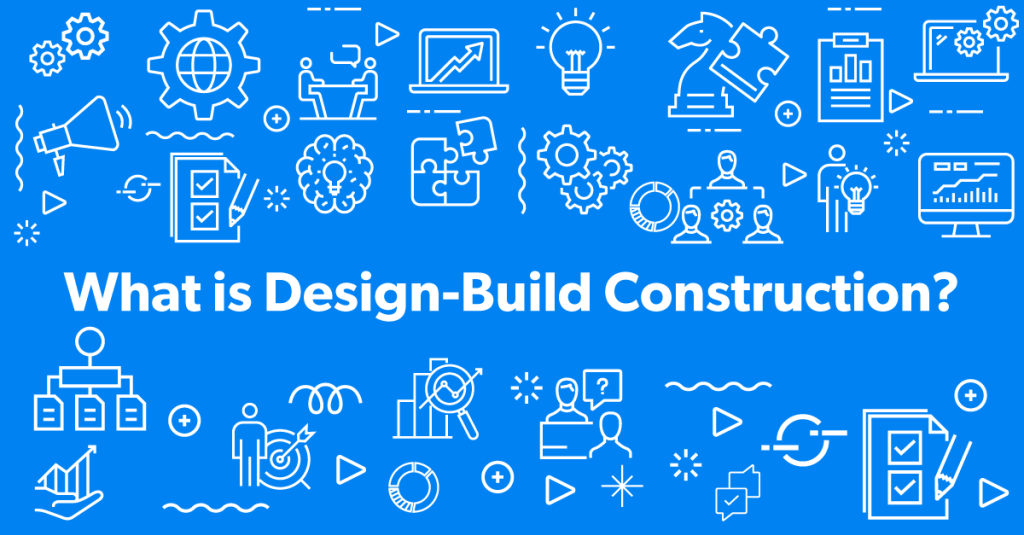Design-build construction is a project delivery method that’s quickly grown in popularity over the past several years. How does design-build construction work, and how can your business best adopt this collaborative approach to project management?
What is design-build?
Design-build construction describes a vertically integrated process for completing a construction project, meaning a single firm designs and builds the project from start to finish.
The Design-Build Institute of America (DBIA) describes design-build construction as “single-source contracting”. The project owner “manages only one contract with a single point of responsibility”.
Design-build vs. design-bid-build
How does design-build construction differ from traditional methods?

Design-bid-build project delivery
Master craftsmen throughout history have designed their own work, but before the current design-build movement gained traction, most modern construction projects utilized design-bid-build delivery.
When using this method, the project owner hires a design firm to create a project blueprint and then requests bids from contractors for the field work. They enter into separate contract agreements with each party.
Project owners need to manage multiple contracts and facilitate communications between at least two different businesses.
Design-build project delivery
The design-build method eliminates the need for multiple contracts. The project owner employs a single firm that handles both the design and build phases of the project.
The benefits of design-build construction

The four main benefits of design build construction are:
Reducing risks
Reducing change orders
Improving collaboration
Increasing profitability
Reducing risks
Using the design-bid-build process, a project owner assumes more legal risk than with the design-build method. Working with two separate entities requires more coordination and close monitoring of a project on the owner’s part.
Design firms may submit blueprints and complete their portion of work before construction companies even draft initial bids. Once a company bids on the project, they expect the final product will not deviate far from initial design plans.
However, if the design firm has made mistakes or failed to include important information in plans, the owner may be held responsible depending on the terms of the contract. They will have to coordinate corrections, and if the schedule or budget cannot accommodate the delay, the construction company may have grounds for litigation.
Using the design-build delivery method simplifies the project management process. The same firm will be creating the initial designs and completing all construction work, so the project owner only needs to coordinate with a single company. That company will be responsible for both project design and all building-related tasks.
Reducing change orders
Change orders refer to any significant alteration to the original plans for a project. These adjustments can involve project scope, budget, or other details and often cause costly delays.
In the above section, we’ve already covered the increased legal risk an owner takes on when a design firm completes their work before the build team begins the construction phase of the project. But, even if the design firm and build firm are working together, you’re more likely to experience the need for change orders using the design-bid-build method than when working with a single company.
For example, the owner may decide to take a project in a different direction based on stakeholder feedback. There may be errors in blueprints that weren’t caught by the design team soon enough. Or, the field team may run into unexpected issues on the jobsite. All of these issues lead to change orders.
The chance of change orders increases with design-bid-build delivery due to the higher likelihood of miscommunications that naturally occurs working with multiple parties. When a single company is responsible for both the design and build, the process is more streamlined.
The design team and contractors are used to working together and will generally make less mistakes.
Improving collaboration
Design-build firms are vertically integrated. Their teams are aligned towards the same goals—the goals of a single business— and share responsibility for the success of a project.
When the design firm and contracting firm are separate, they may develop an adversarial relationship that is difficult for a project owner to manage, especially if change orders or errors happen.
Increasing profitability
Reduced risks, fewer change orders, improved collaboration—All of these benefits make for more efficient, cost-effective construction work.
Design-build firms save project owners valuable time and money.
Disadvantages of design-build construction
Despite the clear benefits of design-build, no project delivery method is perfect. The disadvantages of the design-build approach include:
Lack of competitive bidding
Loss of owner control
Lack of competitive bidding
Competition pushes contractors to offer their best product at the most effective price. In the design-bid-build world, competition can be fierce, and project owners are likely to choose the construction company that offers the lowest pricing to follow through with their pre-made design plans.
Design-build firms have more flexibility because they have control over every stage of a project. While they still need to offer competitive pricing, they have more leverage.
Loss of owner control in design
Project owners may have less influence over project designs in the design-build process. When they hire a firm that specializes in design-build, they place a significant amount of trust in the firm to deliver the complete project.
The firm’s capabilities and understanding of their own resources can affect the design just as much as the project owner’s requirements.
How to implement design-build construction
Implementing the design-build construction method requires the construction firm to take on responsibility of managing communications between design and build teams.
This means less work for the project owner but a greater need for the construction company to develop best communications practices.
Use the right technology
Construction management software like Raken helps general contractors communicate effectively. You can implement Raken’s digital daily reporting tools, time tracking, and project management capabilities to make sure work onsite proceeds on schedule according to design plans.
Raken increases project visibility and helps managers catch and correct errors in design plans or misinterpretations before they develop into change orders or costly rework.
Using Raken’s mobile app, field contractors quickly capture data from the field, including photos and video. They submit reports in real-time, which are shared instantly via cloud storage.
These immediate insights keep projects on track and help all project stakeholders stay informed.
Understand how your team works
Raken’s advanced production insights keep design-build firms aware of current project progress and also help them create better bids. Review performance at a glance and see where design issues or miscommunications affected productivity.
Download branded PDF reports to share with project owners to keep them engaged and demonstrate how your vertically-integrated firm utilizes your resources.
Try Raken
Did you enjoy our design-build construction guide? Raken’s easy-to-use app can help you implement these strategies to improve communication and collaboration at your construction company.
Schedule a demo or download our free trial to learn more about our solutions for daily reporting, productivity tracking, safety management, and more.
